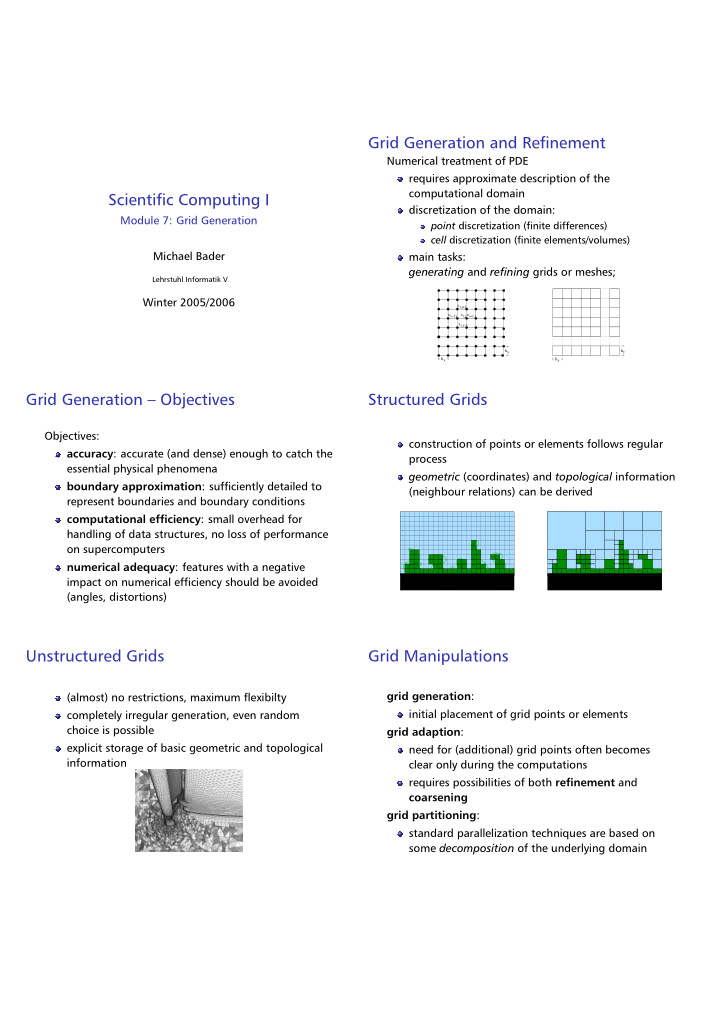



Grid Generation and Refinement Numerical treatment of PDE requires approximate description of the computational domain Scientific Computing I discretization of the domain: Module 7: Grid Generation point discretization (finite differences) cell discretization (finite elements/volumes) Michael Bader main tasks: generating and refining grids or meshes; Lehrstuhl Informatik V Winter 2005/2006 x i,j+1 x i−1,j x i,j x i+1,j x i,j−1 h y h y h x h x Grid Generation – Objectives Structured Grids Objectives: construction of points or elements follows regular accuracy : accurate (and dense) enough to catch the process essential physical phenomena geometric (coordinates) and topological information boundary approximation : sufficiently detailed to (neighbour relations) can be derived represent boundaries and boundary conditions computational efficiency : small overhead for handling of data structures, no loss of performance on supercomputers numerical adequacy : features with a negative impact on numerical efficiency should be avoided (angles, distortions) Unstructured Grids Grid Manipulations grid generation : (almost) no restrictions, maximum flexibilty initial placement of grid points or elements completely irregular generation, even random choice is possible grid adaption : explicit storage of basic geometric and topological need for (additional) grid points often becomes information clear only during the computations requires possibilities of both refinement and coarsening grid partitioning : standard parallelization techniques are based on some decomposition of the underlying domain
Grid Operations Regular Structured Grids rectangular/ cartesian grids: Typical Operations on the Grid: rectangles (2D) or cuboids (3D) numbering of the nodes/cells triangular meshes: for traversal/processing of the grid triangles (2D) or tetrahedra (3D) for storing the grid row-major or column-major traversal and storage for partitioning the grid identify the neighbours of a node/cell neighbouring/adjacent nodes/cells/edges due to typical discretization techniques h y h x Transformed Structured Grids Composite Structured Grids transformation of the unit square to the subdivide (complicated) domain into subdomains of computational domain simpler form regular grid is transformed likewise (ξ(0),η(1)) (0,1) (1,1) (ξ(1),η(1)) and use regular meshs on each subdomain (0,0) (1,0) (ξ(1),η(0)) (ξ(0),η(0)) Variants: algebraic : interpolation-based at interfaces: example: Coons patch conforming at interface (“glue” required?) PDE-based : solve system of PDEs to obtain ( ξ ( x , y ) overlapping grids ( chimera grids) and η ( x , y ) Block Structured Grids Delauney Triangulation assume: grid points are already obtained – how to define elements? based on Voronoi diagrams Voronoi region around each given grid point: V i = { P : � P − P i � < � P − P j � ∀ j � = i } V 3 subdivision into logically rectangular subdomains P P 2 3 (with logically rectangular local grids) V 1 subdomains fit together in an unstructured way, but P V P 2 1 4 continuity is ensured (coinciding grid points) V 4 P P 6 5 popular in computational fluid dynamics V 5 V 6
Delauney Triangulation (2) Point Generation Algorithm how do we get the grid points? Voronoi region around each given grid point: 1 start with a regular grid and refine/modify V i = { P : � P − P i � < � P − P j � ∀ j � = i } boundary-based: connect points that are located in adjacent Voronoi 2 start with some boundary point distribution, regions generate Delaunay triangulation, and subdivide (following suitable rules) leads to set of disjoint triangles (tetrahedra in 3D) 3 if helpful, add point or lines sources (singularities, Applications: bound. layers) closely related to FEM, typically triangles/tetrahedra Advancing Front methods very widespread Advancing Front Methods Advancing Front Methods (2) Advancing algorithm: choose an edge on the current front, say PQ 1 advance a front step-by-step towards interior create a new point R at equal distance d from P and 2 starting from the boundary ( starting front ) Q determine all grid points lying within a circle around 3 R, radius r order these points w.r.t. distance from R 4 P P for all points, form triangles with P and Q; 5 P P 1 1 P P 2 2 select one of these triangles add triangle to grid (unless: intersections, . . . ) 6 update triangulation and front line: add new cell, 7 update edges Adaptive Grids Block Adaptive Grids Characterization of adaptive grids: retain regular structure size of grid cells varies considerably refinement of entire blocks to locally improve accuracy similar to block structured grids sometimes requirement from numerics Challenge for structured grids: efficient storage and processing efficient storage/traversal but limited w.r.t. adaptivity retrieve structural information (neighbours, etc.)
Recursively Structured Adaptive Grids based on recursive subdivision of parent cell(s) leads to tree structures quadtree/octree or substructuring of triangles: efficient storage; flexible adaptivity but complicated processing (recursive algorithms)
Recommend
More recommend